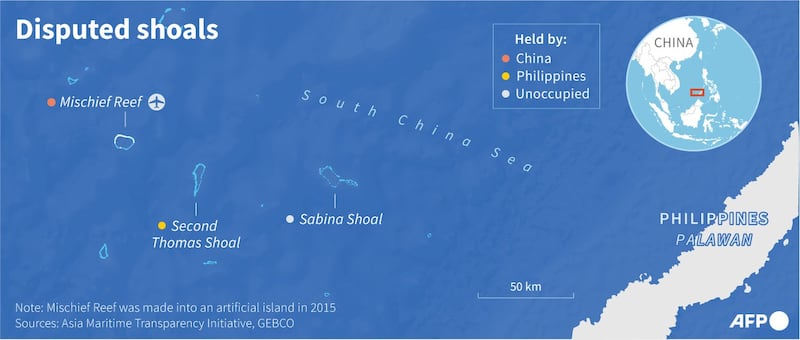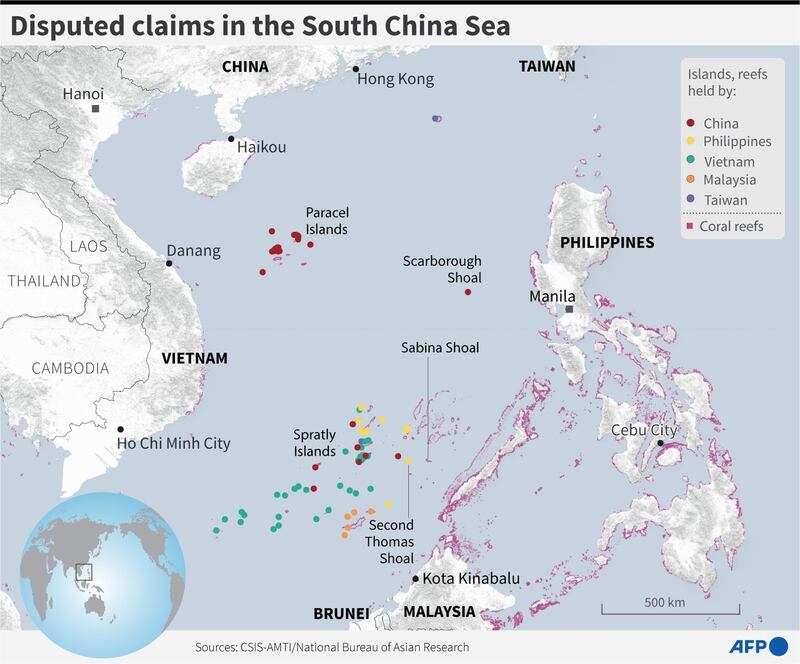Sabina Shoal, located over 75 nautical miles west of the Philippines and 600 miles from China, has become the latest flashpoint between the two rival claimants in the South China Sea.
A months-long standoff began in April when Manila sent one of its largest and most modern ships, BRP Teresa Magbanua, to the shoal amid reports that Beijing could be trying to reclaim land there.
In response, China accused the Philippines of planning to ground the ship there to occupy it.
In August, Manila accused a Beijing ship of ramming BRP Teresa Magbanua several times, the fifth case of alleged harassment by China of Philippine ships operating near the shoal that month. Chinese officials said the Philippine ship acted dangerously and rammed into a Chinese vessel.
See: 2024 Sabina shoal standoff: A timeline
On Sunday, the Philippine Coast Guard pulled BRP Teresa Magbuana from the shoal's waters and sent it back to port after a five-month deployment, citing needed repairs and medical care for crew members. But Filipino officials said they had not surrendered Manila's claim to the area.
What is Sabina Shoal and why is it important for the Philippines?

Sabina Shoal – which the Philippines calls Escoda Shoal and China refers to as Xianbin Jiao – serves as a rendezvous point for resupply missions to nearby Second Thomas Shoal, where the Philippines maintains a World War II-era ship to serve as a military outpost and territorial marker.
Analysts have said that if China takes control of Sabina Shoal, it could prevent the Philippines from conducting resupply missions to the Second Thomas Shoal or reaching the Manila-occupied Thitu island, home to about 400 Filipinos.
Part of a crucial maritime trade route for Manila, the reef is also “a good staging ground for vessels that [could] interfere with Philippine maritime activities extending from Palawan to the West Philippine Sea and the Kalayaan Islands,” said Jay Batongbacal, a Filipino maritime analyst and director of the Institute for Maritime Affairs and Law of the Sea.
Manila calls territories and waters in the South China Sea within its 200 nautical mile exclusive economic zone (EEZ) the West Philippine Sea.

“A hostile China would be able to strangle our maritime trade with the rest of Asia and most of the world from Escoda Shoal,” Batongbacal told BenarNews, an RFA-affiliated online news organization, on Sept. 3.
The South China Sea is a critical world trade route accounting for 21% of global trade (U.S. $3.4 trillion) in 2016, the most recent year these data are available, the U.S. Energy Information Administration said in a report earlier this year.
Sabina Shoal is important to Manila because of its proximity to Reed Bank, another South China Sea feature that is a traditional fishing ground for Filipinos, and has a potential role in the country's energy security because of its rich oil and gas deposits.
Territorial presence
Philippine officials said a new ship will be sent to the Sabina Shoal to replace the BRP Teresa Magbanua, which returned to port.
Two Philippine Navy sources told BenarNews that the country could not send a ship to the shoal anytime soon because of extreme weather conditions.
For its part, China could send dozens of ships to block a Philippine ship if it is stationed at the shoal, according to the sources who requested anonymity because they were not authorized to discuss the issue.
Blocking a Philippine ship “en route to Sabina Shoal is a possible prospect,” especially since Chinese ships appear to be capable of tracking movements at sea, said Collin Koh, a maritime security analyst with the S. Rajaratnam School of International Studies in Singapore.
Another scenario is that Beijing “might tolerate” Manila’s stance on putting a “strategic presence” in the shoal but it “would actively block the [Philippine] ship from entering the lagoon of the feature,” Koh said.
RELATED STORIES
[ Troubled Waters: The South China SeaOpens in new window ]
[ Philippines says it did not surrender Sabina Shoal to ChinaOpens in new window ]
[ Philippines says 200-plus Chinese vessels have clustered in its EEZOpens in new window ]
Unclear strategy
Some military officials, diplomats and analysts – a majority of whom did not want to be identified – have expressed concerns that the Philippines has no cohesive strategy on its South China Sea claim.
In March, the Philippine government created the National Maritime Council to have overall jurisdiction and “direction on policy-formation, implementation and coordination” on all issues affecting the country’s maritime security and domain awareness.
But the country also has the National Task Force on the West Philippine Sea, created in 2016 for similar objectives.
Under the latest order, the task force would be placed under the council. But confusion abounds as several officials are discussing Manila’s claim coming from different agencies including the Philippine Coast Guard, Armed Forces of the Philippines and National Security Council, which are members of the council and the task force.
Jonathan Malaya, assistant director general of the National Security Council and task force spokesman, said the task force is not mandated to provide overall strategy or policy.
“Here in the [task force], we’re more strategic and operational,” he told BenarNews.
Meanwhile, the Philippines needs to step up with its South China Sea strategy, analysts told BenarNews.
“At this point, it’s not clear if the government has a specific game plan to deal with Chinese actions in the West Philippine Sea,” said Rommel Jude Ong, a retired Navy rear admiral and a professor at the Ateneo de Manila University.
“From a naval standpoint, the entire West Philippine Sea is a single theater of operations. Our crisis response should always be looking at the big picture and not to disaggregate incidents in Sabina from whatever is happening elsewhere.”
Another analyst expressed similar concerns.
“It is now wait and see for the Philippines in terms of its plans for Escoda Shoal,” said Julio Amador, a Manila-based analyst with the Amador Research Services, using the Philippine name for Sabina Shoal. “[China] has numbers on its side so the Philippine approach needs to be strategic and not tactical at this point.”
“Whatever path of action the Philippines will take, the whole government must be behind it and the plan should be approved at the highest levels.”
BenarNews is an RFA-affiliated online news organization.
